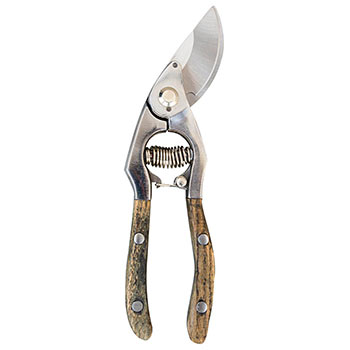Pruning, for many gardeners, is among the most dreaded aspects of growing. A big reason is that no two plants are exactly alike: different sizes, forms and bloom times warrant different pruning techniques. No need to get intimidated, though! Just remember a few guidelines – and you’ll be sure to learn as you go.
Safety:
Always wear protective goggles and gloves – dry wood can snap. One of our Breck’s gardeners also advises that he only prunes when in a good mood – not for his own safety, but for the plants’!
What to prune:
Prune plants that bloom on new wood (wood developed this season) in early spring, before the new growth commences. Plants that bloom on old wood (wood that grew the previous year) should be pruned after they’re done blooming.
Your primary targets should be dead or diseased wood and winter kill. Trim any suckers you find around the tree trunks as well as ornamental grasses you’d left alone for some winter charm. You’ll need to be a little cautious with perennials- make sure you get rid of all the dead foliage without disturbing the crown. Look out for dormant buds, making your cuts just above the swelling. When you’re cutting off the limbs, never remove the collar (the swollen part where the branch meets the main trunk) for it leaves the plant or tree vulnerable to pests and diseases.
Tools:
Using the right tools is paramount. Never compromise on the quality of tools. You must also take care to select the appropriate tools for the task on hand.
The most used of all pruning tools, pruners are best for cutting twigs less than ½” thick. Pruners are of two types- anvil pruners, used to cut pruned branches and dead wood; and bypass pruners, used when you’re cutting into live wood. There are several key differences between the two pruners- anvil pruners crush both sides of the wood as you make the cut. They’re easy to handle and offer greater stability than bypass pruners which crush only one side of the wood when you make a cut. When handling a bypass pruner, make sure the side with the hooked blade is on the same side as the wood that is to be removed. When you need to make a cut flush with the collar, use a bypass pruner.
When you’re tackling large, thick (usually up to 1″) branches, use a lopper. A lopper is much like a pruner, only it has long handles that provide for added muscle and leverage needed for trimming those tough, swarming shrubs.
When the branches are too thick and sturdy for a lopper, it’s time to grab a pruning saw. Modern designs function seamlessly with the sap and have two sets of blades capable of cutting in both pull and push strokes. They fold like a jackknife and are a comfortable fit for the tool belt. The bow saw is used to cut branches or limbs into smaller pieces and the pole saw, which is essentially a saw with a long pole helps you cut branches up high while still remaining on the ground level. Most experts would advise you against using a pole saw for the simple reason that it’s difficult to make precise cuts with it.
Afterwork:
Once you’re done pruning, allow the wounds to dry out naturally instead of using sealers. Also, make sure to sanitize your pruning tools in order to prevent the spread of infection. You can use iso-propyl alcohol wipes, or, for tools that have been used on heavily diseased trees, clean with a 1-to-9 solution of bleach and water. Keep your pruners sharp so your cuts are precise and the damage to the plants is minimal. Use a carbide sharpening tool for the job, and sharpen the curved edge of the blade, leaving the flat back side alone.



